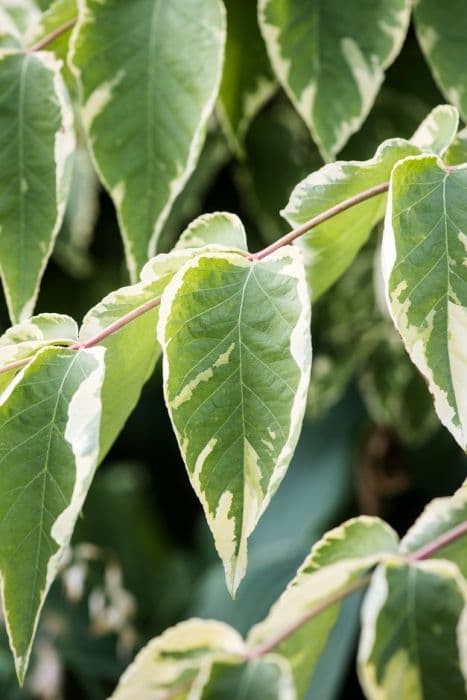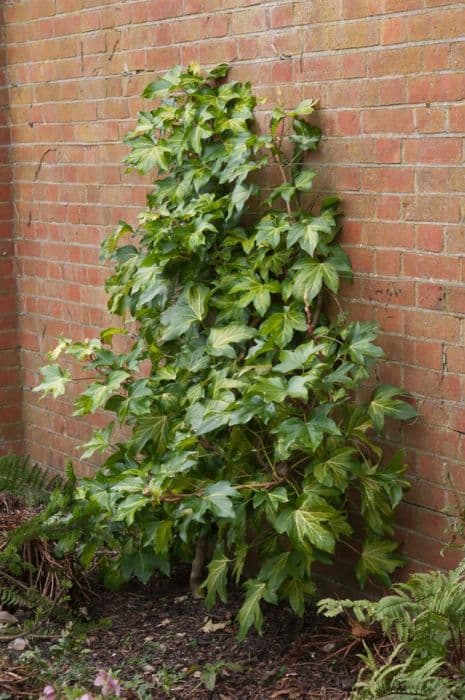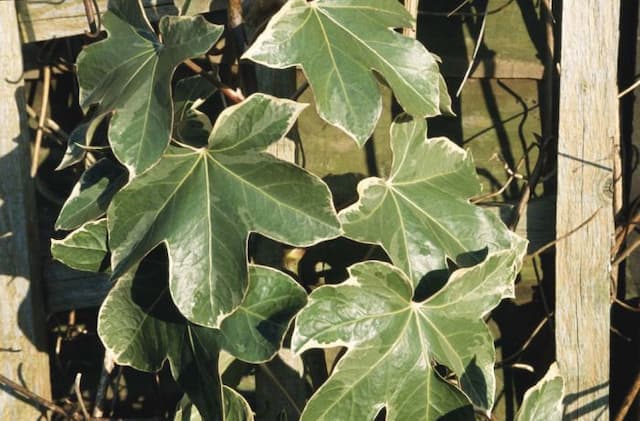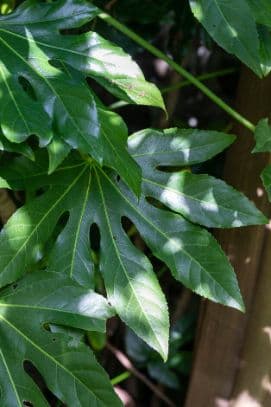English Ivy Hedera helix 'Oro di Bogliasco' (v)

ABOUT
'Oro di Bogliasco' is a variety of English ivy known for its decorative foliage and climbing habit. The leaves of this plant are its most striking feature, often heart-shaped or lobed with a typical ivy appearance. What sets this particular variety apart is the color pattern of its leaves; they exhibit a gold or yellow variegation on the edges, giving a bright contrast against the plant's deeper green center. The leaves are a glossy texture, which can catch the light and add a shimmering effect to the plant as it climbs. English ivy is known for its ability to cling to and cover various surfaces, which means 'Oro di Bogliasco' can often be seen ascending walls, trellises, or other structures, thanks to its aerial rootlets that can grip onto almost any surface. This characteristic makes it an excellent choice for adding greenery upwards in a garden or indoor space. It is also often used in hanging baskets or as ground cover, where its trailing vines can spread out, showcasing the full beauty of its variegated foliage. The plant can adapt to different light conditions, although the variegation may be more vibrant with ample light. It’s important to note that English ivy has a fast growth rate and can be invasive in some areas, so care should be taken when planting it outdoors.
About this plant
 Names
NamesSynonyms
English Ivy, Common Ivy, European Ivy
Common names
Hedera helix 'Oro di Bogliasco'
 Toxicity
ToxicityTo humans
English ivy, including the Hedera helix 'Oro di Bogliasco' variety, is toxic to humans. Ingesting the leaves or berries can result in symptoms such as stomach pain, diarrhea, and vomiting. Contact with the sap can cause dermatitis or skin irritation in sensitive individuals. It is important to avoid consuming any part of the plant and to wear gloves when handling it to prevent skin exposure.
To pets
English ivy is also toxic to pets. If your pet consumes parts of the plant, they can experience similar symptoms to humans, such as vomiting, abdominal pain, hypersalivation, and diarrhea. Cats and dogs may also suffer from skin irritation after contact with the sap. In severe cases, ingestion can lead to more serious conditions such as coma or death if not treated promptly. Owners should ensure that pets do not have access to English ivy and seek veterinary care immediately if ingestion is suspected.
 Characteristics
CharacteristicsLife cycle
Perennials
Foliage type
Evergreen
Color of leaves
Variegated
Height
50-100 feet (15-30 meters)
Spread
5-10 feet (1.5-3 meters)
Plant type
Climber
Hardiness zones
5-9
Native area
Europe
Benefits
 General Benefits
General Benefits- Decorative Appeal: With its variegated leaves of green and yellow, English Ivy 'Oro di Bogliasco' adds visual interest to garden spaces and indoor settings.
- Versatility: It can be used in a variety of ways, such as groundcover, climbing walls and trellises, or hanging baskets.
- Low Maintenance: English Ivy requires minimal care once established, making it suitable for gardeners at all levels of experience.
- Drought Tolerance: Once established, it can tolerate periods of dryness, reducing the need for frequent watering.
- Shade Tolerance: Thrives in low-light conditions where other plants might struggle, making it ideal for shaded gardens.
- Soil Erosion Control: Its dense growth habit helps to stabilize soil on slopes and prevent erosion.
- Cold Hardy: English Ivy is resilient in cooler climates and can survive in temperatures well below freezing.
- Wildlife Habitat: Provides shelter and nesting sites for birds and other wildlife.
- Growing Speed: It grows relatively quickly, which is beneficial when trying to cover an area in a short amount of time.
 Medical Properties
Medical Properties- Expectorant properties: English ivy is traditionally used for its ability to help with respiratory conditions by loosening mucus and making it easier to cough up.
- Anti-inflammatory effects: Compounds in English ivy may help reduce inflammation, which can be beneficial in treating conditions like arthritis.
- Antimicrobial activity: English ivy extracts have been shown to have antibacterial and antifungal properties.
- Antispasmodic uses: The saponins present in English ivy are thought to help relieve muscle spasms and cramps.
- Antioxidant properties: English ivy contains antioxidants that may protect cells from damage by free radicals.
 Air-purifying Qualities
Air-purifying QualitiesThis plant is not specifically known for air purifying qualities.
 Other Uses
Other Uses- Topiary Decoration: "Oro di Bogliasco" can be trained to grow on frames and create living sculptures in gardens, offering a unique aesthetic appeal.
- Natural Food Wrapping: In some cultures, ivy leaves are used as biodegradable wraps for cooking or storing certain types of food.
- Aesthetic Book Covers: The attractive leaves can be pressed and dried to adorn the covers of handcrafted journals or photo albums.
- Privacy Screens: Planted around a patio or balcony, ivy provides a dense screen that offers privacy from neighbors.
- Craft Supplies: The vines can be woven into wreaths, baskets, and other craft items for natural home decorations.
- Camouflage for Structures: Ivy can be used to cover unsightly elements in the garden, such as compost bins or old fences.
- Erosion Control: On slopes or areas prone to soil erosion, ivy's dense growth helps stabilize the soil.
- Thematic Landscaping: Ivy is often used in "gothic" or "romantic" styled garden designs due to its classical associations in literature and art.
- Photography Prop: Photographers sometimes use ivy as a backdrop or feature in portraiture and nature photography for its texture and color.
- Cultural Celebrations: Ivy is included in floral arrangements and decorations for events like weddings or festivals, symbolizing fidelity and friendship.
Interesting Facts
 Feng Shui
Feng ShuiThe English Ivy is not used in Feng Shui practice.
 Zodiac Sign Compitability
Zodiac Sign CompitabilityThe English Ivy is not used in astrology practice.
 Plant Symbolism
Plant Symbolism- Connection and Friendship: English Ivy symbolizes strong emotional bonds because of its ability to latch onto surfaces and stick closely, often representing fidelity and attachment in relationships.
- Eternal Life: With its evergreen nature, English Ivy is often associated with immortality and the perpetuity of life, as it remains green throughout the year.
- Resilience and Survival: It's known for its hardy nature and ability to thrive in challenging conditions, symbolizing the human ability to persevere through hardship.
- Growth and Renewal: The vigorous growth patterns of English Ivy symbolize continuous growth and personal rejuvenation.
- Protection: Traditionally, ivy-covered walls and doors have been thought to protect the inhabitants from negative energies and evil spirits.
 Water
WaterEnglish Ivy prefers to be kept in evenly moist soil without becoming waterlogged. Water your plant when the top inch of soil feels dry to the touch, which typically means watering once a week. Use room temperature water, and apply it directly to the soil, avoiding wetting the foliage to prevent fungal diseases. Depending on the size of the pot and the indoor climate, a rough estimate would be about 24 ounces of water weekly for a medium-sized pot. During the winter or in a cooler climate, reduce the frequency to prevent root rot, as the plant will use less water.
 Light
LightEnglish Ivy thrives in bright, indirect light but can also adapt to low-light conditions. Avoid direct sunlight exposure, especially during the hot summer months, as this can scorch the leaves. A north or east-facing window would be the ideal spot, providing ample light without the harsh intensity of direct sun. If the plant doesn't receive enough light, it may become leggy, so provide supplemental light if necessary.
 Temperature
TemperatureEnglish Ivy does best in moderate temperatures, ideally between 50°F and 70°F, avoiding sudden temperature changes. It can tolerate a minimum temperature of about 30°F but should not be exposed to freezing conditions for prolonged periods. On the higher end, temperatures should not exceed 90°F, as this can stress the plant. The plant will thrive in typical indoor temperatures, which usually fall within its preferred range.
 Pruning
PruningPrune English Ivy to maintain its shape, encourage bushier growth, and remove any dead or damaged leaves. Pruning is best done in the spring or early summer, allowing the plant to recover and grow the most during its active season. Prune as often as required to control growth, using clean, sharp shears to make precise cuts. Regular pruning also helps manage potential pests and improves air circulation around the plant.
 Cleaning
CleaningAs needed
 Soil
SoilEnglish Ivy 'Oro di Bogliasco' prefers a well-draining soil mix with good aeration. A mix of peat, perlite, and compost in equal parts is ideal. This variety thrives in slightly acidic to neutral pH, ranging from 6.0 to 7.5. Ensuring the mix is loose and fertile will support healthy growth.
 Repotting
RepottingEnglish Ivy 'Oro di Bogliasco' should be repotted every two to three years, or when it outgrows its pot. Repotting in spring allows the plant to recover and grow into its new space during the growing season.
 Humidity & Misting
Humidity & MistingEnglish Ivy 'Oro di Bogliasco' prefers moderate to high humidity levels, ideally between 40% to 50%. If indoor air is dry, using a humidifier or misting the leaves regularly can help maintain these humidity conditions.
 Suitable locations
Suitable locationsIndoor
Place in bright, indirect light and monitor water.
Outdoor
Plant in shaded area; protect from afternoon sun.
Hardiness zone
5-11 USDA
 Life cycle
Life cycleThe life cycle of the English Ivy 'Oro di Bogliasco' (v) begins with seed germination, where the seeds sprout when conditions of moisture, temperature, and light are favorable. The seedlings then grow into juvenile plants, characterized by their lobed, trailing leaves and a strong drive to climb and adhere to surfaces through aerial rootlets. As the plant matures, it enters the adult vegetative stage, where the leaves become unlobed and the stems thicken; it's during this stage that the plant focuses on increasing biomass and spreading horizontally or vertically. Subsequently, the adult plant develops umbels of small, inconspicuous flowers during the flowering stage, typically in the late summer to fall, which are pollinated by insects. After pollination, the flowers give way to small, berry-like fruits that mature to a dark blue-black color, containing seeds for the next generation of plants. The plant may remain in the adult stage, continuing the cycle of growth and reproduction, for many years before eventually dying, completing its life cycle.
 Propogation
PropogationPropogation time
Spring-Early Summer
The most popular method of propagating Hedera helix 'Oro di Bogliasco', also known as English Ivy, is by stem cuttings. This can be done virtually any time during the growing season, but the best time is spring through summer. To propagate, select a healthy stem with several leaves and cut it to a length of 4 to 5 inches (approximately 10 to 12.7 centimeters). Remove the leaves from the bottom half of the cutting, and if desired, apply a rooting hormone to the cut end to encourage root development. Place the cutting into a pot filled with moist potting mix, ensuring that at least one set of leaves is above the soil surface. Keep the pot in a warm place with indirect light and maintain consistent moisture. Roots usually develop within a few weeks, after which you can transplant the cutting to a permanent location.









